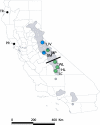Population genetics of the frog-killing fungus Batrachochytrium dendrobatidis
- PMID: 17693553
- PMCID: PMC1945010
- DOI: 10.1073/pnas.0701838104
Population genetics of the frog-killing fungus Batrachochytrium dendrobatidis
Abstract
Global amphibian decline by chytridiomycosis is a major environmental disaster that has been attributed to either recent fungal spread or environmental change that promotes disease. Here, we present a population genetic comparison of Batrachochytrium dendrobatidis isolates from an intensively studied region of frog decline, the Sierra Nevada of California. In support of a novel pathogen, we find low diversity, no amphibian-host specificity, little correlation between fungal genotype and geography, local frog extirpation by a single fungal genotype, and evidence of human-assisted fungus migration. In support of endemism, at a local scale, we find some diverse, recombining populations. Therefore neither epidemic spread nor endemism alone explains this particular amphibian decline. Recombination raises the possibility of resistant sporangia and a mechanism for rapid spread as well as persistence that could greatly complicate global control of the pathogen.
Conflict of interest statement
The authors declare no conflict of interest.
Figures


References
-
- Stuart SN, Chanson JS, Cox NA, Young BE, Rodrigues ASL, Fischman DL, Waller RW. Science. 2004;306:1783–1786. - PubMed
-
- Rachowicz LJ, Knapp RA, Morgan JAT, Stice MJ, Vredenburg VT, Parker JM, Briggs CJ. Ecology. 2006;87:1671–1683. - PubMed
-
- Longcore JE, Pessier AP, Nichols DK. Mycologia. 1999;91:219–227.
Publication types
MeSH terms
Associated data
- Actions
- Actions
- Actions
- Actions
- Actions
- Actions
- Actions
- Actions
- Actions
- Actions
- Actions
- Actions
- Actions
- Actions
- Actions
- Actions
- Actions
- Actions
- Actions
- Actions
- Actions
- Actions
- Actions
- Actions
- Actions
- Actions
- Actions
- Actions
- Actions
- Actions
- Actions
Grants and funding
LinkOut - more resources
Full Text Sources

